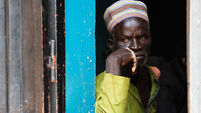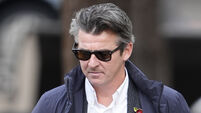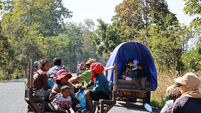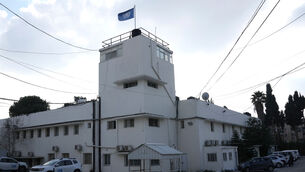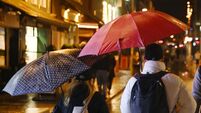Horror in Monrovia: I cried then and I cry now
AP Chief of African News Michelle Faul covered both sides of Liberia’s civil war and the war in Sierra Leone from 1990 to 1994, when she was West Africa Correspondent. Here is her story.
The chopped-off fingers clinging to the railing of a river bridge. The 12-year-old boy who drew a picture of a bloody serrated knife he had used to kill, trying to exorcise ghosts of those he had murdered.
A day that started with a dog eating a corpse, and ended with a family eating their pet dog.
I cried then and I cry now as I drag out of the shadows of memory the horrors of Charles Taylor’s sieges of Monrovia.
Villagers were waving palm fronds and ululating their adoration of Taylor the first time I saw him, on a wild trip behind the rebel lines of Liberia that began with a clandestine crossing over the frontier from Ivory Coast, balancing our old Tandy laptops on our heads as we forded the St John’s river.
That was in May 1990, five months after Taylor launched his Christmas Eve invasion from Ivory Coast.
The debonair, bearded and bespectacled US-trained economist was welcomed as a saviour then, his mission to oust the brutal and corrupt dictatorship of Master Sergeant Samuel Doe.
But I noticed that Taylor, who claimed to be a church-going Christian and later a Baptist preacher under orders from God, was wearing two amulets. One of his guerrillas told me they were “black-magic” charms to protect the wearer from bullets.
Taylor never was wounded in the war he began in Liberia and then spread to neighbouring Sierra Leone.
But the carnage he unleashed killed three million people, more hacked to death with machetes than gunned down. A total of 40,000 people died of starvation during Taylor’s first siege of Monrovia.
In Sierra Leone, a trademark of the rebels he fostered was to hack off people’s limbs, asking victims destined to have their arms chopped whether they wanted “long sleeves or short sleeves”.
Thousands of civilians flocked to Taylor’s cause as he crossed Liberia. By then, he had become known for the ”small boys” he conscripted.
It was a pioneering concept in Africa, an army of child soldiers, some as young as seven with red eyes rolling and drugged, no taller than a car window and hefting guns longer than they were.
“Open your gate!” they’d squeak in Liberian slang, and drivers at their impromptu roadblocks would give up cigarettes and money.
I feared Elizabeth Blunt, an intrepid BBC correspondent, would get us killed since she insisted on giving them candy and cookies instead. They reacted as any child, with glee.
The boy who drew the picture broke down in tears when he had coloured the last drop of blood dripping from the blade of the knife. Then he tore it up, a gesture trauma counsellors said would help him learn to leave the past behind.
Another trademark of Taylor’s fighters was the men dressed in drag, some in looted wedding gowns, topped by blond and red wigs or Mickey Mouse and Donald Duck masks.
As Taylor left the areas of Liberia where he was welcomed by Gio and Mano tribes, he began meeting fierce resistance, and his fighters reacted with equal ferocity.
One morning, on a ride to find out how near the rebels were to Monrovia, I saw severed fingers, still wrapped around the rail above the Po River bridge. The owner of the fingers must have dropped down and drowned.
At a peace march, Doe’s troops fired on unarmed protesters as they crested a hill to descend on the US Embassy.
I remember being glad I was a writer. Our photographer, Alistair Sinclair, raced up the hill into the line of fire. Another reporter, Nicholas Kotch of Reuters, and I fled to the safety of a one-room shack where a mother was nursing a baby.
We came out when the soldiers started shouting they would kill anybody harbouring reporters. My legs shook as we walked, our backs to the soldiers as they fired above our heads and hit tree branches that fell around us.
Sinclair later emerged to say he had hidden in a stinking outhouse for two hours.
One night, the soldiers started banging at my door at the decidedly unpalatial Ducor Palace Hotel, threatening to break it down. No one answered my desperate attempts to call the reception desk. I called the British ambassador, who sent two army officers to my rescue.
With the hotel no longer safe, the Americans found us lodging in a home with two bedrooms and two bathrooms. It eventually would house more than 20 journalists as the siege of Monrovia dragged on.
Soon there was little food in Monrovia. Taylor’s rebels cut the telephones, water and electricity supply.
The day began with a visit to the Ducor Palace and a climb up the dark stairwell of its many floors, then up an iron ladder to the roof that allowed the best view of Taylor’s boys firing shells at the city.
The work day ended early because the only way to send our reports was by 4pm through the British Embassy, which sent them by radio signals to a ship offshore that sent them on to Portsmouth, from where they were distributed by telex to AP, BBC and Reuters.
There were moments of joy. Like the afternoon when American scientists liberated a baby chimpanzee from a research facility as the rebels approached.
The baby’s parents and other chimpanzees had been killed and presumed eaten. The baby leaped into my lap, shaking with fear, and wrapped its arms around my neck. Then it urinated. Still, one of the best hugs of my life.
Walking to the hotel one day, we saw a drunken Liberian soldier wave his gun at a cowering man.
“Please, no!” Blunt begged, causing the trooper to turn his gun on us. Then, swaying in his drunkenness, he turned back to his victim and let off a volley of shots.
As food became scarcer, we held a competition for the best dish. Blunt won for an egg Florentine made of canned spinach and powdered eggs.
That week, some Liberian friends invited me to dinner. They had killed their Alsatian. I begged off. In the morning, I had seen a dog eating a man’s corpse on the beach.
Nigerian warplanes bombed Taylor’s rebels out of Monrovia in 1991.
On Friday morning, it felt strange to be seated 100 yards from Taylor, held since Wednesday at the prison of the international war tribunal of Sierra Leone, where he is indicted on charges of crimes against humanity, sexual slavery and mutilation for masterminding this country’s decade-long conflict to plunder its rich diamond fields.
Taylor, normally cocksure and confident, looked tired, shocked and unsteady when he arrived in a UN helicopter. He had to be helped down the stairs, unsure of his balance since his hands were handcuffed in front of him.
But not as unsteady as some amputees I saw on Friday morning, walking on their artificial limbs.







